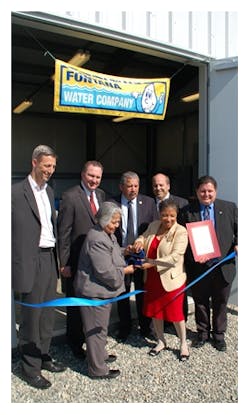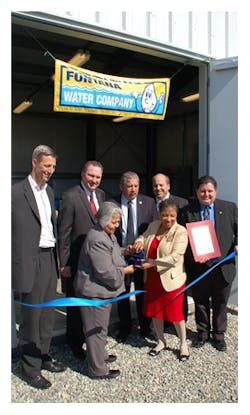CA water company launches innovative small hydropower project
FONTANA, CA, Feb. 24, 2014 -- Fontana Water Company announced today that lawmakers and water company officials launched an innovative hydroelectric generation project that creates enough electricity to power a local water treatment plant (WTP) and provide excess power back to the local utility grid. Known as "in-conduit" hydroelectric generation, the project utilizes existing water flow through Fontana Water's Sandhill Surface WTP in Rialto to produce electricity without burning fossil fuels, making it a renewable and sustainable source of power -- the first of its kind in Southern California.
"Electricity is one of our biggest expenses, so this will help keep those costs down, which in turn will help hold down the cost of water to our customers," said Robert K. Young, General Manager of Fontana Water Company. "By taking advantage of state and federal grants, this is a very cost-effective project for us." Young also emphasized that the electricity produced by the in-line turbines will be "green energy" because they produce zero emissions from the generation of electricity. Electric utilities like Southern California Edison are required by state law to generate more electricity from non-polluting sources like hydro, so the new facility helps meet the state's climate change goals.
Joining the ribbon-cutting ceremony were U.S. Representative Gloria Negrete McLeod (D-Montclair), who represents this area in Congress, and California Assembly member Cheryl Brown (D-San Bernardino), who represents Fontana in the state legislature, and Fontana City Councilman Jesse Sandoval. "Fontana Water Company's small hydro project bordering the communities of Fontana and Rialto is going to make a big difference in the Inland Empire," said McLeod. "For a small federal investment of less than half a million dollars, we've put people to work at good-paying construction jobs, made the water system more reliable and helped control future costs. This one small facility will generate enough electricity to run the entire plant, and it will sell power back to Edison."
State policy also encourages diversification of electric generation infrastructure by providing significant funding for small projects distributed around California. Other state policies require the addition of renewable power and reduction in greenhouse gas emissions. "This power plant is exactly what the state has been trying to encourage with policies on climate change, renewable portfolio standards and distributed generation," said Brown. "The Self Generation Incentive Program was created more than a decade ago to stimulate the development of many small-scale generation systems using a wide variety of technologies."
The in-conduit system used by Fontana Water utilizes the difference in water pressure when the water first enters the plant, which can be 140 psi, and the water pressure needed to safely operate the plant, which is about 10 psi. That difference represents energy that is now being converted to electricity. Further, the Sandhill Hydroelectric Station is comprised one 95 kW turbine and a second 215 kW turbine. Most of the time, the turbines will provide nearly all the power needed to serve on-site power needs at the plant, and during high flows they will be able to export excess electricity to the power grid. Once the project is approved by the CPUC, electric savings will transfer directly to water customers.
Additionally, the project's environmental benefits are equivalent to supplying energy to 194 homes, cutting CO2 emissions by 950 tons and offsetting carbon emissions from 294 vehicles. The cost of the project is approximately $1.7 million, and Fontana has secured two grants for the project -- one from the federal government in the amount of $498,000 and a second from the State of California in the amount of $337,500 -- for a total of approximately $835,500. Construction of the Sandhill Hydroelectric Station began around May of 2013 and completed in November. The plant has been tested and is now in service.
###

